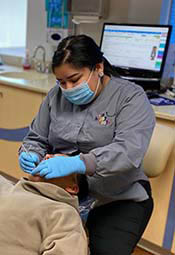Today, more than 15% of American adults suffer from chronic facial pain, such as jaw pain, headaches or earaches, according to the American Dental Association. While TMJ, or TMD, only accounts for a portion of these cases, it remains a serious problem. Much like rehabbing after a leg or shoulder injury, can working out your jaw with TMJ exercises alleviate pain caused by the disorder?
What is TMJ (TMD)? Mistakenly called TMJ because it involves your temporomandibular joints, temporomandibular disorders (TMD) occur when these joints aren’t working properly. As you can see in this brief video, your TM joints impact all areas of your face. So it’s no wonder they can cause a great deal of pain and other issues.
TMJ Exercises
Because individual cases vary greatly, TMJ exercises may alleviate pain for some but not others. The exercises are designed to retrain your jawbone to move correctly without pain while making your muscles stronger.
Following is an exercise recommended by the Oxford University Hospitals to help alleviate TMJ, or TMD, by helping to strengthen the ligaments around your jaw and relaxing the muscles that close your mouth. Find two 5-minute periods each day, when you are relaxed, and perform this exercise while sitting upright in a chair.
- Close your mouth to touch your upper and lower teeth without clenching them. Rest the tip of your tongue on your palate behind your upper teeth.
- Run the tip of your tongue back towards your soft palate as far as you can, keeping your teeth together.
- Force your tongue back gently to maintain contact with the soft palate. Then slowly open your mouth until you feel your tongue being pulled away. Keep your mouth open in this position for five seconds before closing your mouth to relax.
Repeat this process slowly but firmly for five minutes. Use a mirror at first to make sure your teeth are closed straight up and down, and not off to either side.
As you open your mouth, you should feel tension under your chin and in the back of your neck. But you should not hear any clicks or noise from your joints. If you do, restart until the exercise is click-free. Do not perform this exercise more than the recommended 5 minutes twice daily for the first week. But do them as often as you can after that.
Note that you may experience worse pain at first, as your jaw gets used to the new movement. But the pain will subside. And after about 2 or 3 weeks of the exercise, your muscles will be retrained so that your jaw opens and closes smoothly without clicking.
Also, to minimize pain and issues caused by TMD, avoid:
- Biting your nails, lower lip, and your front teeth
- Closing your upper and lower teeth together while resting or sleeping
Exercises to Keep Pain from Coming Back
Once you have retrained your jaw to open and close without pain, whether with exercise or the help of your doctor, you can perform other exercises to keep the pain from coming back. The American Academy of Family Physicians recommends doing these exercises to strengthen your muscles and keep pain caused by TMD from returning.
- Resisted mouth opening: Place your thumb or two fingers under your chin and open your mouth slowly, while pushing up gently on your chin with your thumb. Hold for three to six seconds and then close your mouth slowly.
- Resisted mouth closing: Place your thumbs under your chin and your two index fingers on the ridge between your mouth and the bottom of your chin. Push down gently on your chin as you close your mouth.
- Tongue up: Slowly open and close your mouth while touching the roof of your mouth with your tongue.
- Side-to-side jaw movement: Place an object about .25” thick (for example, two tongue depressors) between your front teeth. Slowly move your jaw from side to side. Increase the thickness of the object as the exercise becomes easier.
- Forward jaw movement: Place an object about .25” thick between your front teeth and move your bottom jaw forward so that the bottom teeth are in front of the top teeth. Increase the thickness of the object as the exercise becomes easier.
These TMJ exercises should never be painful. Stop immediately if they are, and consult with your doctor.
Left untreated, TMD may cause more serious issues, as discussed in “What is TMJ (TMD) and What Causes It?” If you suffer from TMD or TMJ, contact our North Carolina offices to find a trusted dentist focused on making your treatment as pleasant and pain-free as possible.
We Can Help Restore Your Smile From the Inside Out
Switch to a Brighter Smile
Have you redeemed your New Patient Special yet? Take advantage of these savings before it’s gone! Download your coupon and redeem it at any of our conveniently located offices in North Carolina. Our team of MyOrthodontist specialists are excited to help give you a smile you’ve always wanted!


